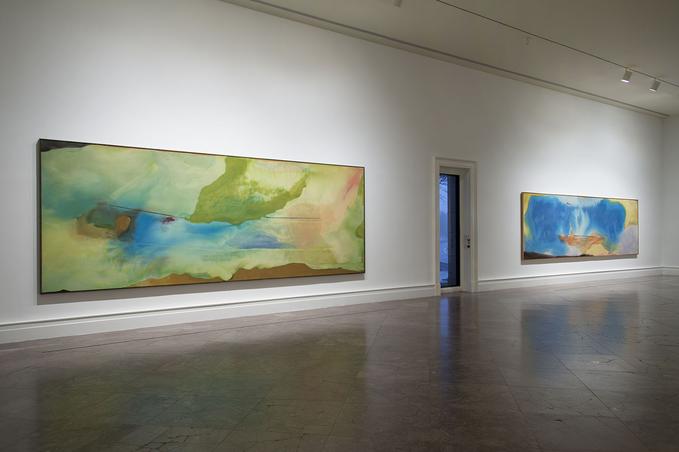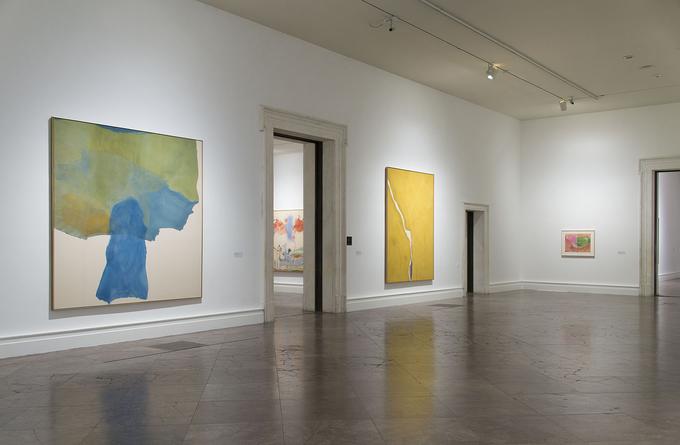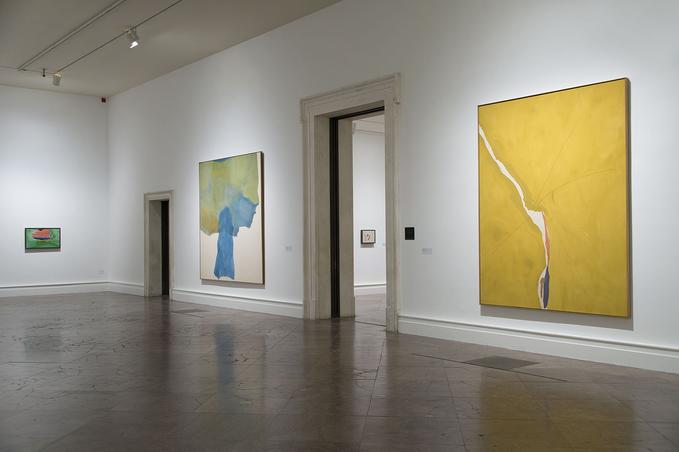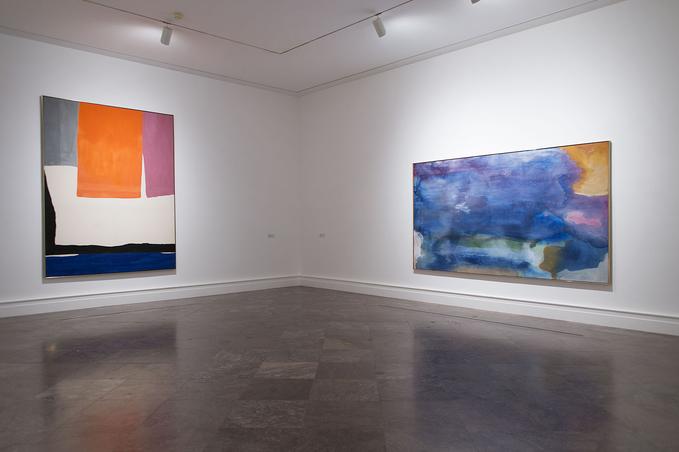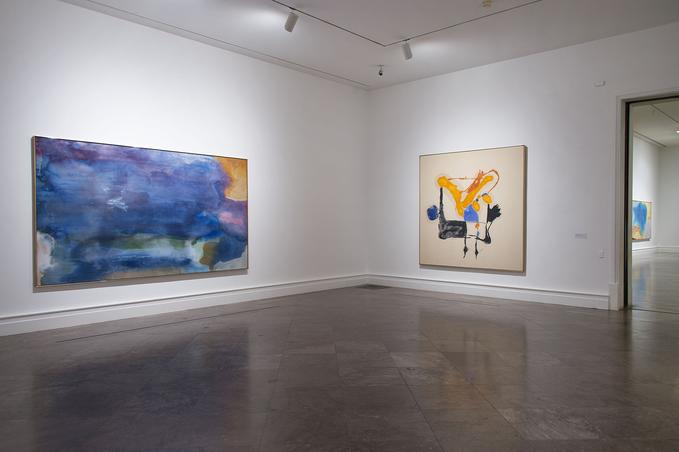Giving Up One’s Mark, Helen Frankenthaler in the 1960s and 1970s
Albright-Knox Art Gallery
Buffalo, NY
November 9, 2014 — February 15, 2015
Press Release / Info
ALBRIGHT-KNOX ART GALLERY PRESENTS
GIVING UP ONE’S MARK: HELEN FRANKENTHALER IN THE 1960S AND 1970S
(Buffalo, NY) – The exhibition Giving Up One’s Mark: Helen Frankenthaler in the 1960s and 1970s, opening on November 9, 2014, at the Albright-Knox Art Gallery, explores a transitional period in the career of renowned American artist Helen Frankenthaler (1928–2011). Featuring more than seventeen paintings and a selection of works on paper, the exhibition tracks the painter’s development during the key decades of the 1960s and 1970s. Drawn from public and private collections, it includes a number of the monumental canvases for which the artist is widely known, as well as smaller works that offer an intimate perspective on her creative process.
“It’s a matter of how you resolve your doubts,” Frankenthaler told a gathering of art and art history students at Harvard University and Radcliffe College in 1976. During an engagement at Bard College in 1977, she raised questions about painting: “What does a painting mean? . . . Does art have a place? . . . Is it necessary?”
What Frankenthaler knew, and what she passionately passed on to the many students she interacted with during the 1960s and 1970s, was that the act of painting still mattered. She was quick to acknowledge the importance of moving forward, embracing change, experimenting with new materials and methods of application, and seeing the future through the past. As Albright-Knox Chief Curator Emeritus Douglas Dreishpoon notes in his essay in the exhibition catalogue, Frankenthaler instinctively adopted Jackson Pollock’s determination to challenge the basic tenets of what painting could be—an ethos that sustained her well beyond her breakout work Mountains and Sea (1952), indeed, for the rest of her artistic life.
Frankenthaler, who began her career as a second-generation Abstract Expressionist, consistently pushed the boundaries of what painting could be by embracing new materials and techniques, abandoning the gestural drawing of earlier work as she transitioned from oil to acrylic paint.
Helen Frankenthaler was born on December 12, 1928. She attended the Dalton School, where she received her earliest art instruction from Rufino Tamayo. In 1949 she graduated from Bennington College, where she was a student of Paul Feeley, following which she went on to study briefly with Hans Hofmann. Her professional 2 of 3 exhibition career began in 1950, when Adolph Gottlieb selected her painting Beach (1950) for inclusion in the exhibition Fifteen Unknowns: Selected by Artists of the Kootz Gallery. Her first solo exhibition was presented in 1951 at the Tibor de Nagy Gallery, and she was also included that year in the landmark 9th Street: Exhibition of Paintings and Sculpture, both in New York. As early as 1959, she began to be a regular presence in major international exhibitions.
One of the foremost colorists of our time, Frankenthaler produced a body of work whose impact on contemporary art has been profound. Her career, which spanned six decades, has been the subject of numerous monographic museum exhibitions and retrospectives, including at The Jewish Museum, the Whitney Museum of American Art, the Solomon R. Guggenheim Museum, The Modern Art Museum of Fort Worth, The Museum of Modern Art, and the National Gallery of Art. A selection of her work from the early 1960s is on view through October 18 in the exhibition Helen Frankenthaler: Composing with Color: Paintings 1962–1963, at Gagosian Gallery, New York. Important works by Frankenthaler can be found in major museums worldwide.
Giving Up One’s Mark: Helen Frankenthaler in the 1960s and 1970s will be accompanied by a fully illustrated catalogue featuring an essay by Dreishpoon that draws on recently transcribed and digitized recordings, provided by the Helen Frankenthaler Foundation, of the artist’s informal sessions with students during the 1960s and 1970s. The catalogue also includes a foreword by Elizabeth Smith, Executive Director of the Foundation, and a Director’s Foreword by Janne Sirén, Peggy Pierce Elfvin Director of the Albright-Knox.
A related public program will take place at the museum on Sunday, November 9, at 11:30 am. This conversation, focusing on Frankenthaler’s work in the 1960s and 1970s, will include Douglas Dreishpoon; John Elderfield, Chief Curator Emeritus at The Museum of Modern Art, New York, who has written extensively on the artist’s life and career; Elizabeth Smith; and artist Clifford Ross, Frankenthaler’s nephew and Chairman of the Helen Frankenthaler Foundation. The program, which will take place in the Albright-Knox’s auditorium, will be free to AK Members and to the public with museum admission. Giving Up One’s Mark: Helen Frankenthaler in the 1960s and 1970s was curated by Douglas Dreishpoon in cooperation with the Helen Frankenthaler Foundation, New York. It will remain on view through February 15, 2013.
For additional information on the Helen Frankenthaler Foundation, visit www.frankenthalerfoundation.org.
The Albright-Knox Art Gallery is recognized as one of the world’s leading collections of contemporary and modern art. With more than 6,500 works in its Collection and a dynamic series of exhibitions and public programs, the Albright-Knox continues to grow and to fulfill its mission to acquire, exhibit, and preserve contemporary and modern art in an enriching, dynamic, and vibrant environment.

